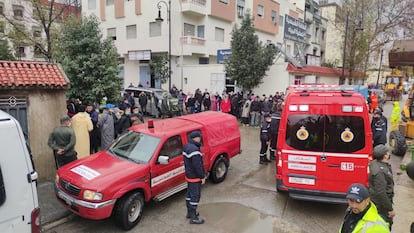What happens to your body when you get an electric shock?
The most common injuries caused by a dangerous brush with electricity are surface wounds, muscle contractions and burns

Injuries produced by receiving an electric shock are relatively common and almost always accidental. More importantly, they are largely preventable. Two age groups are most commonly affected: small children under six years of age, who might touch or suck on a cable, or stick their fingers in a socket, and adults who work with unsecured electrical currents at work, as in the construction sector.
Electric shocks can cause injuries in several ways. The first to consider is the direct effect of the shock, which can cause entry and exit wounds of varying severity depending on the charge and contact time. Secondly, electricity can be converted into heat generating burns – mainly on the skin but even in the internal organs. Between 3 and 4% of admissions to burns units are due to this type of injury. Burns can also happen when clothing catches fire via electrical sparks. Lastly, muscle contractions can cause injury including bone fractures, as we occasionally see when someone is struck by lightning.
The main factor determining the severity of an injury is the power of the electrical charge, i.e. the amount of current that flows through the body. For this reason, we qualify injuries as high voltage when the body has received more than a thousand volts, and low voltage below a thousand volts. High voltage power lines exceed 100,000 volts and lightning has a charge of more than 10 million volts.
When caring for someone who has received an electric shock, we have to assess the voltage they have received, the area that is affected and the total size of their body. The effects of an electric shock on a two-year-old child are not the same as on a hefty adult, even if the voltage is the same.
Burns can range from first degree (the mildest) to third degree (the most serious). Depending on the surface area and depth of the burn, tissue necrosis or cell death may occur, and substances will be released into the bloodstream capable of blocking the kidneys and causing renal failure, requiring dialysis until recovery. Sometimes the peripheral nerves can also be injured, so if a person touches a high-voltage cable, he or she can become paralyzed and suffer a permanent, lifelong decrease in skin sensitivity.
The most serious injury that can occur is electrocution or cardiorespiratory arrest when an electrical current flows through our body. Electrocution below 500 volts normally causes malignant arrhythmias that lead to cardiorespiratory arrest. In the case of lightning, the heart may stop suddenly (flatlining, or asystole). In either case, cardiopulmonary resuscitation must be prolonged because the cardiac tissue is not injured, but the arrhythmia or asystole is caused by the electric shock. These patients survive more frequently than those who suffer other types of cardiac arrest.
Blunt trauma
Finally, bone fractures can happen either as a consequence of intense muscular contractions or because the power of the discharge can throw you backwards and cause serious blunt trauma when you land.
All possible injuries must be closely monitored as exposure to electrical currents may cause a small entry wound and slight skin burns, but may also have caused significant internal injuries that initially pass unnoticed. Low-voltage currents, such as household electricity supply, do not usually cause serious injury.
In any case, prevention is simple and easy to ensure, especially at home and in the workplace, so we must remain vigilant to avoid injuries caused by electric shock.
Begoña Zalba Etayo is the head of the Multi-Role Unit at the ICU in the Hospital Clínico Universitario Lozano Blesa in Zaragoza.
Tu suscripción se está usando en otro dispositivo
¿Quieres añadir otro usuario a tu suscripción?
Si continúas leyendo en este dispositivo, no se podrá leer en el otro.
FlechaTu suscripción se está usando en otro dispositivo y solo puedes acceder a EL PAÍS desde un dispositivo a la vez.
Si quieres compartir tu cuenta, cambia tu suscripción a la modalidad Premium, así podrás añadir otro usuario. Cada uno accederá con su propia cuenta de email, lo que os permitirá personalizar vuestra experiencia en EL PAÍS.
¿Tienes una suscripción de empresa? Accede aquí para contratar más cuentas.
En el caso de no saber quién está usando tu cuenta, te recomendamos cambiar tu contraseña aquí.
Si decides continuar compartiendo tu cuenta, este mensaje se mostrará en tu dispositivo y en el de la otra persona que está usando tu cuenta de forma indefinida, afectando a tu experiencia de lectura. Puedes consultar aquí los términos y condiciones de la suscripción digital.
More information
Últimas noticias
The metaverse, four years later: Is it finished or just at a standstill?
$3,000 and a plane ticket: The United States increases incentives for migrants to self-deport before the end of the year
Charles Dubouloz, mountaineering star, retires at 36 with a farewell tour inspired by Walter Bonatti
From the White House to diplomatic gifts: Lego wins over adult fans, brick by brick
Most viewed
- The low-cost creative revolution: How technology is making art accessible to everyone
- Christian Louboutin: ‘Young people don’t want to be like their parents. And if their parents wear sneakers, they’re going to look for something else’
- All the effects of gentrification in one corner of Mexico’s Colonia Roma
- Christmas loses its festive spirit: ICE fears cast shadow over religious celebrations
- Liset Menéndez de la Prida, neuroscientist: ‘It’s not normal to constantly seek pleasure; it’s important to be bored, to be calm’









































